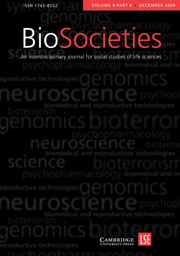Crossref Citations
This article has been cited by the following publications. This list is generated based on data provided by
Crossref.
Mackenzie, Adrian
2010.
Design in synthetic biology.
BioSocieties,
Vol. 5,
Issue. 2,
p.
180.
Gisler, Monika
Sornette, Didier
and
Woodard, Ryan
2010.
Exuberant Innovation: The Human Genome Project.
SSRN Electronic Journal,
Rapp, Rayna
2011.
Chasing Science: Children’s Brains, Scientific Inquiries, and Family Labors.
Science, Technology, & Human Values,
Vol. 36,
Issue. 5,
p.
662.
Gisler, Monika
Sornette, Didier
and
Woodard, Ryan
2011.
Innovation as a social bubble: The example of the Human Genome Project.
Research Policy,
Vol. 40,
Issue. 10,
p.
1412.
2012.
Current Bibliography of the History of Science and Its Cultural Influences, 2012.
Isis,
Vol. 103,
Issue. S1,
p.
i.
Hogan, Andrew J.
2014.
The ‘Morbid Anatomy’ of the Human Genome: Tracing the Observational and Representational Approaches of Postwar Genetics and BiomedicineThe William Bynum Prize Essay.
Medical History,
Vol. 58,
Issue. 3,
p.
315.
Nelson, Nicole C.
2015.
A Knockout Experiment: Disciplinary Divides and Experimental Skill in Animal Behaviour Genetics.
Medical History,
Vol. 59,
Issue. 3,
p.
465.
D'Abramo, Flavio
and
Neumeyer, Sybille
2020.
A historical and political epistemology of microbes.
Centaurus,
Vol. 62,
Issue. 2,
p.
321.
Bangham, Jenny
2022.
New Meanings in the Archive: Privacy, Technological Change and the Status of Sources**.
Berichte zur Wissenschaftsgeschichte,
Vol. 45,
Issue. 3,
p.
499.
Simons, Massimiliano
2022.
The hidden life of molecular biology.
Metascience,
Vol. 31,
Issue. 2,
p.
207.
Chen, Esther
Keuck, Lara
and
Nickelsen, Kärin
2022.
The Politics of Sources Meets the Practices of the Librarian: An Interview with Esther Chen**.
Berichte zur Wissenschaftsgeschichte,
Vol. 45,
Issue. 3,
p.
508.
Falkenberg, Ruth
Sigl, Lisa
and
Fochler, Maximilian
2024.
From ‘making lists’ to conducting ‘well-rounded’ studies: Epistemic re-orientations in soil microbial ecology.
Social Studies of Science,
Vol. 54,
Issue. 1,
p.
78.
2024.
Intangible Intangibles.
p.
224.
de Cock, Wessel
and
Reinhardt, Carsten
2024.
Narratives of contingency and practices of comparing in the emergence of German molecular genetics (1958–1968).
Studies in History and Philosophy of Science,
Vol. 107,
Issue. ,
p.
118.
Topcu, Zeki
Krischel, Matthis
and
Fangerau, Heiner
2025.
Molecular biology as a “playground” in the life sciences: Questions on the current status of molecular biology.
Endeavour,
Vol. 49,
Issue. 1,
p.
100981.


